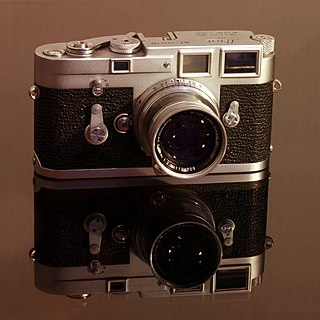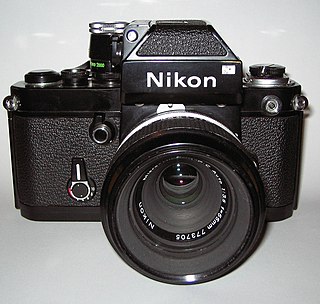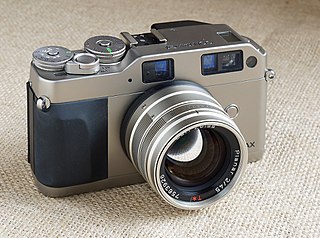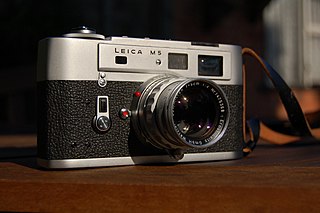
A single-lens reflex camera (SLR) is a camera that typically uses a mirror and prism system that permits the photographer to view through the lens and see exactly what will be captured. With twin lens reflex and rangefinder cameras, the viewed image could be significantly different from the final image. When the shutter button is pressed on most SLRs, the mirror flips out of the light path, allowing light to pass through to the light receptor and the image to be captured.

A rangefinder camera is a camera fitted with a rangefinder, typically a split-image rangefinder: a range-finding focusing mechanism allowing the photographer to measure the subject distance and take photographs that are in sharp focus. Most varieties of rangefinder show two images of the same subject, one of which moves when a calibrated wheel is turned; when the two images coincide and fuse into one, the distance can be read off the wheel. Older, non-coupled rangefinder cameras display the focusing distance and require the photographer to transfer the value to the lens focus ring; cameras without built-in rangefinders could have an external rangefinder fitted into the accessory shoe. Earlier cameras of this type had separate viewfinder and rangefinder windows; later the rangefinder was incorporated into the viewfinder. More modern designs have rangefinders coupled to the focusing mechanism so that the lens is focused correctly when the rangefinder images fuse; compare with the focusing screen in non-autofocus SLRs.

The Nikon F camera, introduced in April 1959, was Nikon's first SLR camera. It was one of the most advanced cameras of its day. Although many of the concepts had already been introduced elsewhere, it was revolutionary in that it was the first to combine them all in one camera. It was produced until October 1973 and was replaced by the Nikon F2. Aspects of its design remain in all of Nikon's subsequent SLR cameras, through the current Nikon F6 film and Nikon D6 digital models. The "F" in Nikon F was selected from the term "re-f-lex", since the pronunciation of the first letter "R" is not available in many Asian languages. That tradition was carried all the way through their top line of Nikon cameras until the introduction of the Nikon D1 (digital) cameras decades later.

Leica Camera AG is a German company that manufactures cameras, optical lenses, photographic lenses, binoculars, rifle scopes and microscopes. The company was founded by Ernst Leitz in 1869, in Wetzlar, Germany.
Kiev is a Soviet and Ukrainian brand of photographic equipment including cameras manufactured by the Arsenal Factory in Kiev, Ukraine. The camera nameplates show the name "KIEV", with older cameras using "КИЕВ" or "КИЇВ" in Cyrillic.

Contax began as a camera model in the Zeiss Ikon line in 1932, and later became a brand name. The early cameras were among the finest in the world, typically featuring high quality Zeiss interchangeable lenses. The final products under the Contax name were a line of 35 mm, medium format, and digital cameras engineered and manufactured by Japanese multinational Kyocera, and featuring modern Zeiss optics. In 2005, Kyocera announced that it would no longer produce Contax cameras. The rights to the brand are currently part of Carl Zeiss AG, but no Contax cameras are currently in production, and the brand is considered dormant.

The Leica M3 is a 35 mm rangefinder camera by Ernst Leitz GmbH, introduced in 1954. It was a new starting point for Leitz, which until then had only produced screw-mount Leica cameras that were incremental improvements to its original Leica (Ur-Leica). The M3 introduced several features to the Leica, among them the combination of viewfinder and rangefinder in one bright window, like on the Contax II, a bayonet lens mount, and rapid film advance lever. It was the most successful model of the M series, with over 220,000 units sold by the time production of the M3 model ended in 1966.

The Nikon F2 is a professional-level, interchangeable lens, 35 mm film, single-lens reflex (SLR) camera. It was manufactured by the Japanese optics company Nippon Kogaku K. K. in Japan from September 1971 to 1980. It used a horizontal-travel focal plane shutter with titanium shutter curtains and a speed range of 1 to 1/2000 second plus Bulb and Time, and flash X-sync of 1/80 second. It had dimensions of 98 mm height, 152.5 mm width, 65 mm depth and 730 g weight. It was available in two colors: black with chrome trim and all black.

The history of the single-lens reflex camera (SLR) begins with the use of a reflex mirror in a camera obscura described in 1676, but it took a long time for the design to succeed for photographic cameras. The first patent was granted in 1861, and the first cameras were produced in 1884, but while elegantly simple in concept, they were very complex in practice. One by one these complexities were overcome as optical and mechanical technology advanced, and in the 1960s the SLR camera became the preferred design for many high-end camera formats.

The Pentax LX is a 35 mm single-lens reflex camera produced by Pentax in Japan. It was introduced in 1980 and produced until 2001. The LX uses the K mount which is the Pentax proprietary bayonet lens mount. It has manual and aperture priority automatic exposure modes. It is the top-of-the-line "professional" or "system" camera in the Pentax manual focus range, and has a large range of accessories. Compared with contemporary professional camera bodies from rival manufacturers, like the Canon New F-1 or Nikon F3, the LX body is smaller and lighter, weighing in at 570 grams with standard FA-1 finder.

The Foca camera was a French-built brand of rangefinder cameras made by Optique & Précision de Levallois.

The Contax G camera line consists of two cameras, the G1 and G2, interchangeable-lens cameras sold by Kyocera under the Contax brand in competition with the Leica M7, Cosina Voigtländer Bessa-R, and Konica Hexar RF. The G1 was introduced in 1994 with the G2 joining it in 1996. In 2005, Kyocera retreated from the camera business and announced it would cease all activity related to the manufacture of Contax cameras at the end of the year, effectively spelling the end of the G system.

The Nikon S3 is a professional level, interchangeable lens, 35 mm film, rangefinder camera introduced in 1958. It was manufactured by the Japanese optics company Nippon Kogaku K. K..

The Konica Hexar RF is a 35 mm rangefinder camera which was sold by Konica. It was introduced to the market on 13 October 1999. and subsequently discontinued some time before the end of 2003. The camera used the "Bayonet Konica KM-mount", a copy of the Leica M-mount, thus sharing interchangeable lenses with those designed for Leica cameras and others compatible with them. The Hexar RF has a combined rangefinder/viewfinder modeled on that of Leica cameras, a similar body shape and size - and so is similar to Leica M-mount cameras in many aspects of operation.

The Bessa family of cameras was manufactured in Japan by Cosina as a revival of the Voigtländer brand name.

The Leica M5 is a 35 mm camera by Leica Camera AG, introduced in 1971. It was the first Leica rangefinder camera to feature through-the-lens (TTL) metering and the last to be made entirely in Wetzlar by hand using the traditional "adjust and fit" method.

The Kodak Retina Reflex is a discontinued series of four single-lens reflex cameras made by Kodak, continuing the brand Kodak Retina.

The Nikon S-mount is a type of interchangeable lens mount used by a series of Nikon 35mm rangefinder cameras. The lenses were sold under the name Nikkor.

The Nikon was the first camera introduced by the optical manufacturer Nippon Kogaku KK. It is a 35mm rangefinder camera, in retrospect known as the Nikon I. The original design was approved by September 1946, and the camera was released in March 1948. At first, it was sold locally, and it did not come to the attention of the western media until 1950, when photographers from the magazine Life were shown photographs taken with these cameras. The lenses draw special attention, like the Nikkor-P.C 1:2 f=8.5cm. A demand to fit Nikkors to the reporters' Leicas were immediately met at the factory in Tokyo, and soon the word spread about these Japanese lenses which were just as good as, or possibly better than their German counterparts. The camera design was strongly inspired by the German Contax and Leica cameras. After careful studies of these, Nippon Kogaku had decided to base their camera on the Contax, but substitute the complicated shutter design for the cloth focal plane shutter of the Leica, these being considered the best features from either camera.

The Kodak 35 was introduced in 1938 as the first US manufactured 35mm camera from Eastman Kodak Company. It was developed in Rochester, New York when it became likely that imports from the Kodak AG factory in Germany could be disrupted by war.


















